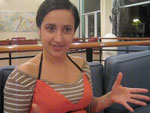 Course: AAAS 7: Women, Gender and Sexuality in the Caribbean
Course: AAAS 7: Women, Gender and Sexuality in the Caribbean
Instructor: Reena Goldthree
For this project, you will work in small groups of three to create a short documentary film. You and your group members will select the specific topic of the documentary; however, your film must critically examine some aspect of women’s lives in the Caribbean before 1960. For your film, you can choose to analyze the life of a specific Caribbean woman, investigate a social movement led by women (i.e., the campaign for women’s suffrage), or examine major topics such as slavery and indentureship with a focus on women’s lived experiences.
By creating an original documentary, you will have the opportunity to explore the issues that we have discussed in class through the visual medium of film. You will also be able to research a topic that interests you and communicate your findings to your peers and the broader public. Rather than simply telling a story about the past, your documentary should make a compelling argument—using voice-over narration, audio, and relevant historical images and film—about the topic you choose to explore. Your argument should be informed by relevant primary and secondary sources beyond the assigned course readings. Each documentary should be 5-6 minutes and must include a bibliography. The final cut of your documentary will be due on March 1, 2011. We will screen and discuss the documentaries in class on March 2, 2011.
To help you create your documentary, you will attend two special workshops. The first workshop, led by librarian Amy Witzel, will explore how to find relevant primary and secondary sources for your film. The second workshop, led by Susan Simon at Jones Media Center, will review multimedia composition techniques and provide basic training in iMovie and Photoshop. In addition, you will complete several mini-assignments in the process of creating the documentary, including an oral “pitch” of your topic, a written film treatment, and a draft script and storyboard.
Learning Outcomes
After completing this project, students will be able to:
-
- Discuss how race, class, sexuality, and nationality have shaped the opportunities available for various groups of Caribbean women
-
- Identify some of the major social, political, and cultural institutions that have sought to define women’s roles in Caribbean society
- Produce polished multimedia compositions that have an original perspective, clear argument, supporting evidence, and proper citations
Assessment
Since this is a collaborative project, your group will receive a grade for the written treatment, storyboard, script, and bibliography. Your group will also receive a grade for the final documentary film. As a class, we will work together to develop a rubric to assess the documentaries.
You will receive an individual grade for your written reflection on the filmmaking process.
Resources
Reena Goldthree, Instructor for AAAS 7
Contact: Reena.N.Goldthree@Dartmouth.edu
Susan Simon, Media Learning Technologist, Jones Media Center
Contact: Susan.Simon@Dartmouth.edu
Amy Witzel, Reference Librarian for African and African American Studies (AAAS) & Women and Gender Studies
Contact: Amy.L.Witzel@Dartmouth.edu
Kay Yi, Writing Assistant for AAAS 7
Contact: Kye.H.Yi@Dartmouth.edu
AAAS 7 Library Resources Guide (prepared by Amy Witzel)
http://researchguides.dartmouth.edu/aaas7
AAAS 7 Blackboard Page (see “Video Project Resources” link)
Student Center for Researching, Writing, and Information Technology (RWIT)
Website: https://students.dartmouth.edu/rwit/


 Course: Hearing Voices Through Invisible Walls: The Art(s) of Facilitation
Course: Hearing Voices Through Invisible Walls: The Art(s) of Facilitation